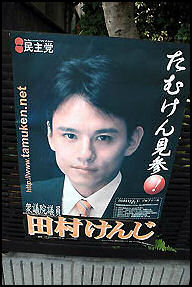POLITICAL PARTIES IN JAPAN
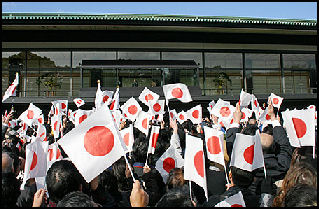 Ruling party: Liberal Democratic Party (LDP), which has dominated Japanese politics since World II . It was voted out of power in the August 2009 elections but returned to power after the December 2012 election. Major opposition party: Minshuto (Democratic Party of Japan, DPJ) came to power for the first time after elections in the August 2009 but was trounced in the December 2012 elections.
Ruling party: Liberal Democratic Party (LDP), which has dominated Japanese politics since World II . It was voted out of power in the August 2009 elections but returned to power after the December 2012 election. Major opposition party: Minshuto (Democratic Party of Japan, DPJ) came to power for the first time after elections in the August 2009 but was trounced in the December 2012 elections.
A survey in October 2008, found that 69 percent of Japanese were disenchanted with the LDP and 50 percent said they were also disenchanted with the DPJ. One Western observer told AP, "Japanese politics are in a deep, deep dilemma. There are no political parties that can attract voters on the basis of their platforms. It's very hard to them apart." Shigeru Ishiba of the LDP Policy Research Council told the Yomiuri Shimbun, “There are people who are disappointed with the DPJ but they don’t want to support the LDP. They’ve ended up supporting no party.”
With the exception of the LDP political parties regularly change name, split and merge and often don’t seem very different from one another.
Also See Articles Under Modern History
Websites and Resources
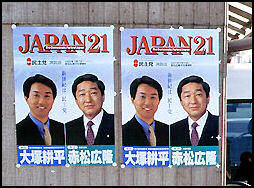
political poster Good Websites and Sources: Wikipedia List of Japanese Political Parties Wikipedia ; Introduction to Japan’s Political Parties kanzaki.com/jinfo ;Democratic Party of Japan (DPJ, Minshuto) dpj.or.jp/english ; Liberal Democratic Party (LDP) jimin.jp ; Japanese Communist Party (Nihon Kyosantou) jcp.or.jp ; New Komeito komei.or.jp/en
Nationalists and Right Wing Groups in Japan Photos of Elections and Right Wing Extremists National Diet Building at Japan-Photo Archive japan-photo.de ; Japan’s Right Wing jack-donovan.com/mishima ; Right Wing Rising articles.sfgate.com ; Right Wing Lunatics lewrockwell.com ; Yasukuni Shrine yushimatenjin
Links in this Website: GOVERNMENT AND SYMBOLS IN JAPAN Factsanddetails.com/Japan ; JAPANESE PRIME MINISTER AND PARLIAMENT Factsanddetails.com/Japan ; POLITICS AND ELECTIONS IN JAPAN Factsanddetails.com/Japan ; POLITICIANS IN JAPAN Factsanddetails.com/Japan ; BUREAUCRACY IN JAPAN Factsanddetails.com/Japan ; CORRUPTION AND GOVERNMENT SCANDALS IN JAPAN Factsanddetails.com/Japan ; TAXES, WELFARE AND SOCIAL SECURITY IN JAPAN Factsanddetails.com/Japan ;
Good GovernmentWebsites and Sources: Wikipedia article on the Government of Japan Wikipedia ; Wikipedia article on the Japanese Flag Wikipedia ; Government Organization Chart kantei.go.jp and kantei.go.jp/foreign/link/chart ; Statistical Handbook of Japan Government Chapter stat.go.jp/english/data/handbook ; 2010 Edition stat.go.jp/english/data/nenkan ; News stat.go.jp Governments on the WWW — Japan Linksgksoft.com ; Japan Echo, a Journal on Japanese Politics and Society japanecho.com ; Electronic Journal of Japanese Studies japanesestudies.org
Prime Minister, Legislature and Leaders: CIA List of Current World Leaders /www.cia.gov/library ; Kantei, Office of the Prime Minister kantei.go.jp ;Cabinet Office cao.go.jp ; House of Representatives (Shugiin) shugiin.go.jp ; House of Councillors (Sangiin) sangiin.go.jp/ ; National Diet Library ndl.go.jp/en National Diet Building in Tokyo Photos of National Diet Building at Japan-Photo Archive japan-photo.de ; Wikipedia Wikipedia ; Japan Visitor Japan Visitor ; Japanese Lifestyle japaneselifestyle.com.au Constitution Constitution of Japan solon.org/Constitutions/Japan ; Birth of the Constitution of Japan ndl.go.jp/constitution ; Research Commission on the Constitution shugiin.go.jp ;
Japan Heading Towards a Two Party System?
Japanese politics began heading toward a two-party system between the Democratic Party of Japan and the Liberal Democratic Party after the former merged with the Liberal Party in 2003. Right after the 2000 general election, the two parties held 75 percent of the 480 seats in the House of Representatives. That percentage increased to 86 percent after the 2003 lower house election. Although it fell to 85 percent in 2005, the total share rose to 89 percent in 2009. Particularly in single-seat constituencies, which account for 300 seats, the two parties held a dominant 91 percent share in the 2003 election. The share fell to 90 percent in the 2005 election, but reached 95 percent in the 2009 election. These figures show how the combination of single-seat constituencies and proportional representation blocs in 1996 has purportedly promoted a two-party system.[Source: Yomiuri Shimbun, December 6, 2012]
An increasing number of voters have begun to describe themselves as not affiliated with any political party, indicating weakening party loyalty in recent years. However, surveys conducted by The Yomiuri Shimbun have shown the percentage of nonaffiliated voters added to that of DPJ and LDP supporters has hovered around 90 percent since 2003. As the total share of DPJ and LDP supporters among voters surveyed has fluctuated between 30 percent and 60 percent, party loyalty among voters has become increasingly weak.
Ideological conflicts, which dictated voter loyalty, have weakened and the influence-peddling political system has become less functional. Furthermore, conventional parties have failed to keep voters whose values have diversified. "They have become mere mutual aid organizations to help members survive elections," said Tomoaki Iwai, a professor at Nihon University. As a result, it has become easier for a lawmaker to defect to another party if a party's public approval ratings decline.
Japan's election system for the House of Representatives, which combines single-seat electorates and proportional representation blocs, was based on the single-seat constituency system in Britain, which has had a two-party system for a long time. In Britain, however, the first coalition government after World War II was formed as a result of a general election in May 2010, in which the Liberal Democratic Party and other smaller parties won more seats than before, leaving the two major parties, the Conservative Party and Labour Party without a majority. The Liberal Democrats decided to join the Tories in coalition government. Prof. Kensuke Takayasu of Seikei University, who specializes in British politics, said the two major parties in the country have been losing their influence with voters, whose values have diversified due to improved living standards, among other factors.
Liberal Democratic Party of Japan (LDP)
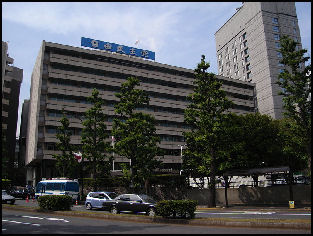
LDP Headquarters in Tokyo The Liberal Democratic Party (LDP) has dominated Japanese politics since it was established in the mid 1950s and has ruled Japan since 1955, with the exception of a brief period in the early 1990s. The LDP is not liberal and in the view of some not very democratic either. It is not even a party but rather a system. Members tend to be conservative and pro-business. Important businesses carry a lot of weight in the party through advisory boards that exert influence in all levels of the government and the bureaucracy.
Takeshi Sasaki, a professor of politics at Gakushuin University in Tokyo, told the New York Times, the LDP ruled through much of the cold war with a hazily conservative platform built upon the bedrock of a close alliance with the United States, which also became a market for its exports. At the same time, it built up an imposing political machine that redistributed the fruits of Japan’s postwar economic miracle to voters in less developed rural regions. [Source: Martin Fackler, New York Times, February 24, 2010]
Until a few years ago the main dynamic for political change in Japan has come from confrontations within the LDP and the breakup and realignment of political parities not by votes from the general public.
The LDP had 1.17 million rank and file members in 2008. Its coalition partners have been the New Komei Party and Hoshuto (New Conservative Party).
As of 2010, 20 percent of LDP lawmakers were 70 or older. Half the lawmakers of the Liberal Democratic party have inherited their seats from their fathers and, as of the late 1990s, 32 from the grandfathers. Many high-ranking members attended Waseda and Keio University. A surprising number of higher-ranking politicians were members of the Waseda University oratorical society (a debating and speechmaking club).
Some LDP members have links to extreme rightist groups and some extremists in their own right. One member wrote a book entitled “Hitler's Election Strategy — The Bible for Sure Victory in Modern Elections”.
Ichiro Hatoyama and the LDP
The first head of the of the LDP was Ichiro Hatoyama, (1883-1959). He was seen as the most likely person to be prime minister after World War II but initially was barred from running for the office by the Americans for his involvement in the war. As Prime Minister Hatoyama restored diplomatic ties with the Soviet Union in 1956. Ironically He is the grandfather of Yukio Hatoyama, leader of the opposition DPJ.
During World War II Ichiro Hatoyama served as education minister and clashed with Prime Minister Tojo on government policy. For a time he lived in exile in Karuizawa, Nagano Prefecture, where he heard the Japanese Emperor announce Japan’s surrender. While there he read extensively from a book about “fraternal revolution” by the Austrian diplomat Richard Coudenhove-Kalergi, who also influenced his grandson and his dream of a united Asia.
After World War II, Ichiro Hatoyama founded the Liberal Party and was expected by many to become prime minister. However, he was purged from the government by the American occupiers on the grounds that his activities in the diet during the war raised some questions.
Hatoyama and Yoshida were two very different men and their battles were legendary. While Yoshida was known for his expensive tastes Hatoyama was regarded as a folksy man of the people. The two leaders split Japan’s conservative block following World War II. When Hatoyama was finally allowed to return to public service he urged Yoshida to support an orderly transfer of power to him. Yoshida snubbed this suggestion and Hatoyama rallied the nation’s “anti-Yoshida forces” and embarked on fierce power struggle with his rival. As head of the Democratic Party Hatoyama eventually wrestled power from Yoshida and became prime minister.
While serving as prime minister, Hatoyama oversaw the merger of the Liberal Party and the Democratic Party in 1955 — a merger of conservative forces to create the Liberal Democratic Party. Hatoyama became the first president of the LDP in 1956.
The LDP’s main rival the Japan Socialist Party was established not long before by leftist and rightist Socialist parties.These two parties remained the dominate ones until 1993.
LDP After World War II
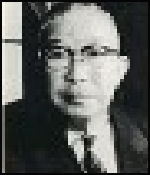
LDP founder Hatayama The LDP ruled all but 10 months between 1955 and the present either with an outright majority or with coalition partners.
The post-war Japanese political scene was characterized by a domination of the Liberal Democratic Party (LDP), fights and shoving matches in the Diet (the Japanese parliament), and a debate between left-wingers proud of Japan's pacifist status and right-wingers who wanted Japan to be an economic superpower and regain its military strength. The conservatives also pressured the government not to fully apologize to other nations in Asia about atrocities committed in World War II.
The LDP thrived under protection of the United States, and pushed its agenda “for “growth, growth, growth” and stamped out opposition. Buruma argued that dependancy on the United States for defense “kept right-wing reactionism alive and polarized political opinion on the one thing where there should have been consensus: the Constitution itself.”
The American writer Richard Katz wrote that Tanaka melded "the corruption of a Ferdinand Marcos and the interest-based politics of a Richard Daley." He made Japan Inc. into a global business powerhouse with his program to "Rebuild the Japanese Archipelago" and forged "Iron Triangles” between business, the bureaucracy and the Liberal Democratic Party. The cornerstone of Iron Triangle patronage system was getting government ministries to approve huge public works programs and granting the contracts to construction companies which employed retired bureaucrats and LDP loyalists and supported the LPD further by getting out the vote for the LDP in the areas where they were based.
Liberal Democratic Party Structure and Elections
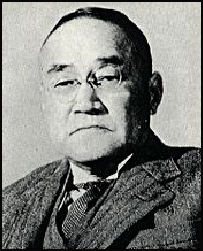
LDP icon Yoshida Being selected as the LDP president has traditionally been the equivalent of being prime minister. Around 800 voting members within the party select the president. The murky selection process for LDP president is often more important in determining the future of Japan than elections.
The three top executive posts of the LDP are: general council chairman, policy research council chairman and secretary general. Deals are often hammer out by fixers. LPD fixers reportedly offer as much as $1 million for key votes to reject no confidence votes.
The election within the LDP for the LDP leader is effectively the election for the Prime Minister. In the LDP president election in 2008 that determined the prime minister there were 527 votes were cast: 386 by Diet members (with 304 from lower house and 83 from the upper house) and 141 from representatives of the party’s prefectural branches, with each of the 47 branches holding three votes. All 47 branches held elections to chose the three members who would vote. In the case there are more than two candidates and no candidate secures a majority a run off is held with the top two vote-getters. The time between when the LDP election was called and when it took place was less than two weeks.
How the Liberal Democratic Party of Japan Chooses Its Leader
In an article describing how Japan’s two main political parties chose their leaders in September 2012, the Yomiuri Shimbun reported: “The Liberal Democratic Party's presidential election is a race for a total of 499 votes--199 cast by Diet members and 300 representing rank-and-file members--where candidates aim to garner a majority of 250. Each LDP lawmaker is given one ballot, excluding the vice speaker of the House of Representatives and the vice president of the House of Councillors, who have temporarily left their respective LDP parliamentary groups in the Diet. Until recently, this left 200 LDP Diet members eligible to vote. However, one LDP lower house member submitted a letter of resignation to the party on Sept. 11, and the LDP's executive board decided to reduce the total of Diet members' ballots to 199. [Source: Yomiuri Shimbun, September 19, 2012]
As for rank-and-file votes, each of the 47 prefectural chapters is initially given three ballots, or 141 in total, with the remaining 159 distributed based on the number of party members in each chapter. The chapters' ballots will be assigned proportionally to candidates under the so-called D'Hondt method based on the actual number of votes they garner. Under this method, each candidate's total number of ballots is divided by one, two, three and succeeding integer numbers. The one with the largest quotient at each turn receives a point.
Voting methods are decided by each prefectural chapter. In many cases, prefectural chapters choose voting through a special reply-paid postcard on which a member writes the name of the candidate he or she chooses and sends it back to the chapter. Unlike the Democratic Party of Japan's system, the LDP's system does not give any preferential treatment to would-be candidates who will run on the LDP ticket in future Diet elections and who do not presently have Diet seats. They are treated the same as rank-and-file members in the poll.
Rank-and-file members, in principle, are allowed to cast ballots in party presidential elections when an LDP president's three-year terms expires. Rank-and-file members' votes throughout the country have been converted into 300 ballots since 2003, when then President Junichiro Koizumi was reelected. They also voted in the 2006 presidential poll, in which candidates fought to succeed Koizumi. Rank-and-file members voted again in the September 2009 election for the successor of then President Taro Aso, who resigned from the post to take responsibility for a disastrous defeat in the lower house election, because the LDP treated it as if it were an election due to the expiration of Aso's term.
As several candidates often run in the election it is possible that no candidate will be able to garner a majority in the first vote. In this case, only Diet members will vote in a runoff between the top two candidates. There have been three incidences of LDP presidential elections being decided by runoff votes. The first was in December 1956, in which Nobusuke Kishi, Tanzan Ishibashi and Mitsujiro Ishii competed to succeed then President Ichiro Hatoyama. Kishi received the most votes and Ishibashi was second. When they competed in a runoff, Ishibashi succeeded in gaining the cooperation of Ishii and his aides, and Kishi was defeated. In the history of LDP presidential elections, it was the only time that a second-place finisher in the first round rebounded to win the subsequent runoff. The other two runoff decisions were in July 1960, when Hayato Ikeda, Ishii and others competed, and another in July 1972, which was dubbed the "Kaku-Fuku war," as Kakuei Tanaka and Takeo Fukuda led a four-man race. In the two races, Ikeda and Tanaka got the most votes in the first round. Both won a majority in their respective runoffs and gained the post of the LDP president.
After 2009 when the LDP became an opposition party the weight of rank-and-file members' votes increased sharply to exceed that of Diet members' votes compared with past elections when the LDP was a ruling party. Due to the disastrous defeat in the 2009 lower house election, the number of LDP lower house members was sharply decreased. It currently stands at less than 120. About 60 percent of the voting power in this presidential election is held by rank-and-file members. An LDP member said, "Unlike races from some time ago, the presidential election's results will not be decided simply by an alliance between factions." Though the LDP has not released membership figures since 2009, the figure as of the end of 2008 was 1,056,263.
LDP membership is given only to Japanese citizens. Rank-and-file members who are allowed to vote in presidential elections are members or supporters aged 20 or older who have paid dues for two consecutive years. The fee for a general rank-and-file member is 4,000 yen a year. LDP faction leaders, as well as upper house members who were elected through the proportional representation system with the backing of such organizations, used to make the utmost effort to gain as many votes as possible from such rank-and-file members. In recent years, however, attitudes of the rank-and-file members have diversified, and many lawmakers feel that it has become difficult to exercise control over their voting actions. An LDP source said: "Rank-and-file members have views that are not so different from those of ordinary citizens. There has been an increasing tendency for the results of public opinion polls by media companies to be reflected in their voting behavior.”
Liberal Democratic Party Factions
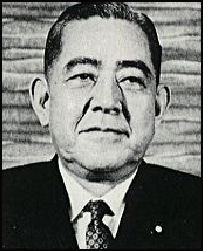
LDP icon Sato LDP politics — and thus Japanese politics — is characterized more by power struggles between factions than competition between individuals with their own viewpoints. LDP factions often vote as a block. The relative strength of any LDP administration depends on the size and strength of faction from which the administrative body comes. LDP politics within the party is often dominated by factions. The factions have traditionally offered their support for a candidate to be prime minister in return for cabinet posts.
The faction system was dealt a plow by Koizumi, who acted unilaterally without necessarily consulting with the main factions first and relied on charisma, populous action and popular support, to ram his policies through. The factions were brought back by Prime Minister Abe and even more by Prime Ministers Fukuda and Aso,
As of late 2007 the major LDP factions were the Machimura faction, headed by Foreign Minister Nonutake Machimura, with 80 members; the Tsushima faction, headed by Finance Minister Fukushiro Tsushiima with 67 members; the Koga faction, headed by former LDP Secretary Makoto Koga with 38 members; and the Yamasaki faction, headed by former Vice President Taku Yamasaki with 80 members.
Liberal Democratic Party Patronage and Pork
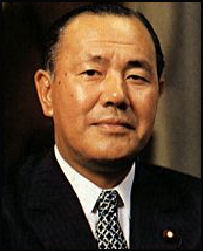
LDP icon Tanaka The LDP has dominated Japanese politics by supporting the interests of small farmer by blocking food exports and providing pork barrel subsidies and coddling to the interests of large corporations by promoting exports and giving subsidies. The LDP has traditionally enjoyed rock solid support in rural areas by funneling money from the cities into the countryside and supporting generous public works projects.
The fishing industry, for example, has traditionally been strong supporters of the LDP. A member of fishermen's cooperative told the New York Times, "Historically, we are all dependant on the government and ruling party for handouts."
During elections many LDP candidates give few interviews and make few speeches or political appearances. Instead they rely on major businesses and professional associations in their districts to campaign of their behalf, mainly by putting up posters everywhere, getting out the vote.
The system worked and was supported by urban Japanese as long as the economy was in good shape. When a long term recession set in the 1990s, urbanites began questioning the system while rural Japanese relied on it more than ever.
Even though many Japanese dislike the LDP they vote for it because they are caught up in the LDP patronage system. Many people have voted for the opposition parties simply do so because they hate the LDP. In recent years hard working opposition candidates, who go out and press the flesh, have made inroads against entrenched LDP candidates.
Unnecessary Public Works Projects in Japan
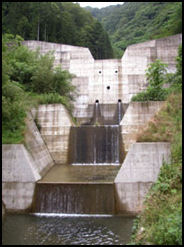
one of hundreds of dams A lot of LDP-authorized government money has gone to build grand dams, bridges, railways and roads, plus countless smaller projects, that Japan doesn't really need. Cities are full of vacant public buildings and government-funded museums and concert halls that no one uses. In the countryside there are expensive government-funded project that have been dubbed tunnels and bridges to nowhere. Much of money to pay for the bridges nowhere often comes from postal saving system, pension contributions, bonds and postal life insurance premiums — one of the primary reason has the highest debt to GDP ratio in the developed world.
The government has funded multi-billion dollar bullet trains, expressways and bridges that serve only a few people, gigantic overpasses that provide access to small country lanes, useless dams, and "airports for radishes.” There are airports with no planes that pay passengers to use them and deep-water ports with no ships. Over 60 percent of Japan's coastline and the riverbeds of many major river bank are fortified or covered with concrete that serves little purpose other than to create ugliness.
Liberal Democratic Party Scandals
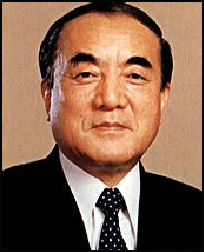
LDP icon Nakasone The LDP has had so many leaders and cabinet members who resigned in disgrace it is hard to keep track of them all.
During Lockheed Scandal, Prime Minister Kakuei Tanaka was forced to resign in 1974 as a result or corruption allegations. In 1976, he was arrested for taking bribes in the scandal in which the aircraft maker Lockheed channeled funds to top officials in the Japanese government in return for their help in a deal to sell L-1011 Tri-Star jets to All Nippon Airways.
The Lockheed scandal broke in February 1976 when a Lockheed executive, A. Carl Kotchian, testified before the U.S. Congress that Lockheed gave money to foreign officials to selll Lockheed aircraft. The accusation led to the indictments of 16 Japanese politicians, including Tanaka. Kodama Yoshio, one of the founders of the LDP, was charged with accepting huge payments from Lockheed. Tanaka was convicted in a lower court and died in 1993 while appealing his case to the Japanese Supreme Court.
Prime Minister Noboru Takeshita was forced out of office in April 1989 after members of his party, the LDP, were implicated in the shares-for-favors Recruits scandal, the worst political crisis in Japan since the end of World War II. LDP leader Shin Kanemaru was among those forced to resign. One of Takeshita’s top aides committed suicide. Many thought he chose suicide to avoid revealing any wrongdoing about his boss.
In the Recruits scandal, LDP lawmakers accepted pre-flotation shares of Recruit Cosmos Co., a real estate subsidiary of the Recruits group, with the understanding the shares would soar in value when the they were listed on the Tokyo stock market. In return the lawmakers granted Recruit favors which helped it expand its business.
Some 70 politicians and insiders purchased stock before the company was listed. When it was listed people already holding stocks made a killing. After the deals became public in 1988, 11 Diet members were investigated on bribery charges but not indicted. The trial for the Recruit scandal lasted for 13 years and involved 322 hearings.
Takeshita resigned as prime minister after taking full responsibility for the Recruits scandal but that wasn’t the only misdeed he was linked to. Later it was discovered that Takeshita's aides had asked the Japanese mafia for help to win an election. In 1993 his closest aid was indicted on tax evasion charges after millions of dollars of gold bullion and bearer bonds were found in his closet.
See Corruption
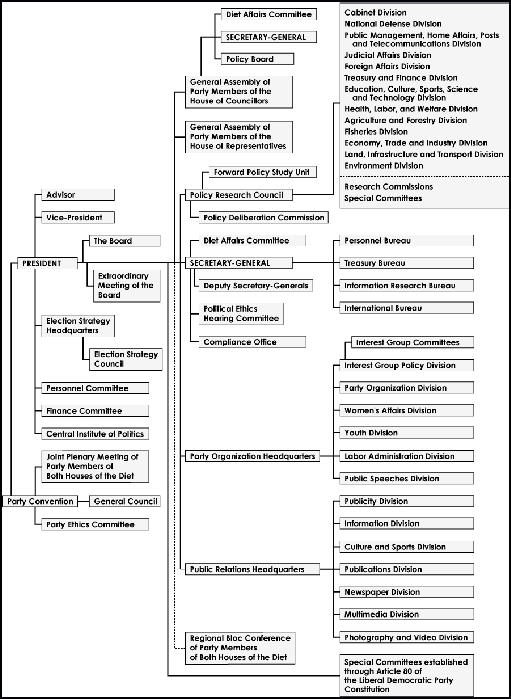
LDP organization
Fall of the LDP After Losing in 2009
In September 2009, 54-year-old former finance minister Sadakazu Tanigaki was voted in as the new LDP leader. He easily beat two other younger rivals in their 40s and was seen as the “safe” candidate young enough to represent a change of the guard and fresh enough to inject of new blood into the LDP. Tanigaki drew some attention when he showed up at a press briefing with a black eye and other slight facial injuries. An avid cyclist, he crashed his bicycle in a one-person accident during a Sunday outing.
Since being defeated in 2009 the LDP has come across as weak, rudderless, confused and even more lacking in a clear strategy to reform and rebuild Japan than the DPJ. It seems more like a party bent on complaining, criticizing and obstructing everything the DPJ does rather than one that offers a fresh vision and new direction for Japan to go. Even some LDP members feel this way.
Martin Fackler wrote in the New York Times, “What does a political party built on power and patronage, with few philosophical or ideological underpinnings, do when it is defeated and driven into the opposition? In the case of Japan’s once formidable Liberal Democratic Party, it implodes like an old Las Vegas hotel being demolished. This has led to hand-wringing in the Japanese press that the nation may be headed toward another period of de facto one-party government, only this time with the ascendant Democratic Party in charge. [Source: Martin Fackler, New York Times, February 24, 2010]
“To see how far the Liberal Democrats have fallen, look no further than the party’s cavernous headquarters in central Tokyo. The nine-story building, once the unchallenged seat of political power during much of the Liberal Democrats’ half-century rule of Japan, has fallen eerily quiet and underused since the party’s historic election defeat the summer of 2009.”
“The party has become an empty shell of its former self,” fackler wrote. “Thrust into the role of opposition party for the first time since its creation in 1955 (aside from a brief interlude in 1993), and with its number of lawmakers cut in half by 2009's humiliating defeat, the party appears demoralized, devoid of fresh ideas and threatened by defections. Lawmakers defected after the election, and the party’s public approval ratings have never bounced back from the high teens, even as the the DPJ has suffered a series of money scandals and produced weak, unpopular leaders. The party’s own internal newspaper, the weekly Liberal Democrat, even warned that the party had virtually no hope of survival.”
“We haven’t had experience as an opposition party,” said Sadakazu Tanigaki, the Liberal Democratic Party told the New York Times. “People are running around wondering, “What do we do?”
LDP Strategies and Problems and Inability to Reform

2013 election
Without it patronage machine, the LDP risks flying apart. In that, analysts say, it is more like the PRI in Mexico, which has yet to recover from its battering in 2000 after more than 70 uninterrupted years in power, than like political parties in the United States and Europe. “We never found a new direction after the fall of the Berlin Wall,” said Sadakazu Tanigaki, the LDP party chief told the New York Times, “and we are regretting that now.” [Source: Martin Fackler, New York Times, February 24, 2010]
Martin Fackler wrote in the New York Times, “The party’s shortcomings have become painfully apparent since its defeat, as it has failed to offer a clear-cut alternative to the Democrats’ vaguely left-leaning plans to offer more aid to families and become more independent from Washington. Instead, the Liberal Democrats have adopted a short-term strategy of attacking the prime minister, Yukio Hatoyama, for the funding scandals involving him and the Democrats’ power broker, Ichiro Ozawa. This has brought some support from voters as seen in the poor showing of DPJ candidates in local and upper house elections. But political analysts and politicians say the approach could backfire if it appeared to lead Japan back into its former political paralysis.”
“Indeed, there is growing frustration among conservatives at the party’s inability to change. This became apparent in September 2009 when Mr. Tanigaki, 65, defeated a younger opponent, Taro Kono, 47, to lead the defeated party. Many younger lawmakers saw this as a move by the party’s old guard to squelch Mr. Kono’s promises to rejuvenate the party by such steps as abolishing its entrenched factions.”
“Mr. Kono said the Liberal Democrats’ only hope of victory was to reinvent themselves as a truly conservative party, with a clear agenda of small government and close ties with the United States. But he sounds a very pessimistic note about the party’s future, so long as the old guard holds sway. “People don’t want the old Liberal Democratic Party,” Mr. Kono said. “They want us to come back as a new, healthier party.”
LDP Factions and New LDP OffShoot Parties the 2009 Election
After the LDP was ousted from power it’s once powerful factions lost their power, prestige and access to funds as the number of unaffiliated members reached a record high.. Within a year and half after the 2009 LDP’s loss they were viewed as so weak that some called them “harmless.” The factions used to have their offices in places like the Grand Prince Hotel Akasaka in Tokyo. In their weakened state they rented out offices in regular commercial buildings to save money.
The factions have traditionally given out grants called “koori-dai” and“ moch-dai”, which literally means “money for buying ice” in the summer and “money for buying mochi” in the winter. After the LPD was ousted from power the amount of these grants dropped to quarter of what they once were.
In April 2010, prominent members of the LDP — former Finance Minister Kaoru Yosano and former Trade Minister Takeo Hiranuma and three other prominent lawmakers broke away from the LDP and formed a new party — the Sunrise Party. Tokyo mayor Shinatro Ishihara supported the new party but didn’t join it. Ishihara wanted to call the party Tachiagare Nippon, which literally means “Stand Up, Japan .” Not long after that former Health, labor and Welfare Minister Yoichi Masuzoe quit the LDP and formed a new party. In March 2010, Kunio Hatoyama — the brother of then Prime Minister Yukio Hatoyama — resigned from the LDP, expressing an interest in forming his own party.”
Image Sources: 1) 2) Wikipedia, 3) 4) 5) 7) 10) Kantei, Office of Japanese Prime Minister site, 6) 12) Japan Zone, 8), 9) Minshuto 11) Ray Kinnane, Posters, right wing, Japan Photo japan-photo.de ;
Text Sources: New York Times, Washington Post, Los Angeles Times, Daily Yomiuri, Times of London, Japan National Tourist Organization (JNTO), National Geographic, The New Yorker, Time, Newsweek, Reuters, AP, Lonely Planet Guides, Compton’s Encyclopedia and various books and other publications.
Last updated September 2016

